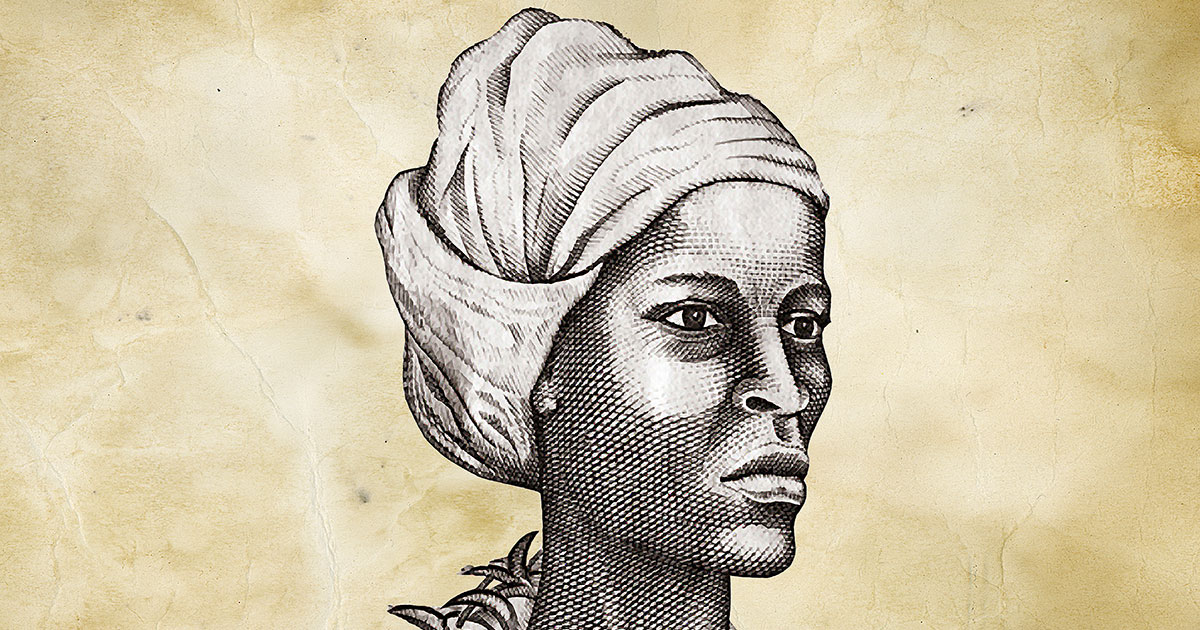“Nana Yaa Pokua” is the original name of this great lady, enshrined in the history of Jamaica.
In the present day, many people refer to her as “Nanny of the Maroons”, ONH.

Photo credit: The Paris Review
History books have her as the one person who diligently led many other people on the path of emancipating themselves.
She often used a particular tool named the “Abeng” horn, to signal the fighters on surprise attacks.

Photo credit: InsideJourneys
In 1975, the government of Jamaica declared Nanny their only female national hero by celebrating her success as a leader.
Her image is printed on the Jamaican $500 note, which is referred to as a “Nanny” since 1995.

Photo credit: Ghanaian Museum on X
According to Wikipedia,
“She led a community of formerly-enslaved escapee slaves, the majority of them West African in descent, called the Windward Maroons, along with their children and families.
At the beginning of the 18th century, under the leadership of Nanny, the Windward Maroons fought a guerrilla war lasting many years against British authorities in the Colony of Jamaica, in what became known as the First Maroon War”.

Photo credit: Caribbean National Weekly
According to Enslaved.org,
“In the legend that distinguishes Maroons from Jamaicans, Nanny and her sister, Sekesu, arrived in Jamaica.
Nanny escaped into the mountains, establishing the lineage of Maroons; Sekesu remained enslaved, establishing the lineage of Jamaican non-Maroons.

Photo credit: HAAS
Alongside this mythical arrival in Jamaica, a growing consensus among contemporary Maroon leaders argues that Nanny arrived in Jamaica with her brother, Kojo, known in some accounts as Cudjoe.
Kojo was the leader of the Leeward Maroons in the mountainous Cockpit Country in western Jamaica”.

Photo credit: Research Gate
More so, Wikipedia says that,
“During the years of warfare, the British suffered significant losses in their encounters with the Windward Maroons of eastern Jamaica. Maroons attributed their success against the British to the successful use of supernatural powers by Nanny, while historians believe that the Maroons’ mastery of guerrilla warfare and vast knowledge of the natural terrain played a significant role in their successes.
Having failed to defeat them on the battlefield, the British sued the Maroons for peace, signing a treaty with them on 20 April 1740.
The treaty stopped the hostilities, provided state-sanctioned freedom for the Maroons, and granted 500 acres (202 ha) of land to Nanny and her followers.
The village built through that land grant still stands, and is called Moore Town or the “New” Nanny Town. Modern members of Moore Town celebrate 20 April 1740 as a holiday, known informally in places today as “4/20” or “four-twenty”.

Photo credit: Wikidata
She is surely passed on by now but her legacy lives on forever, both in Jamaica and in Africa!
I love you, girl!



She sounds like a really brave woman and I’m happy she was able to escape into the mountains, I wish Sekesu could have joined her. She looks like she was a very beautiful woman as well. She deserves to be remembered.
❤️👏🏿
This is an amazing story. She did amazing things for her people, and she was such a powerful force for good in a world that was so dark.
👍🙏🏽
Thanks for all the info on Nanny! Interesting. I love that she was recognized in a culture who keeps women down. It’s inspirational to all woman leaders!
👍🙏🏽
WOWWWW, what a fascinating story—thank you so much for sharing Nanny’s story with us! From what I’ve read, she was truly an inspiring woman. It’s wonderful to see how her contributions and dedication to her people have been recognized. Nanny was undoubtedly a pillar of strength and leadership in her time.
👍🙏🏽
What an incredible woman she is. A true hero of the world. Nanny’s remarkable leadership and pivotal role in emancipating her community are truly inspiring. May her legacy continue to flourish.
😍🙏🏽
As a Jamaican I truly appreciate you covering one of our national heros on your blog. she is truly a phenomenal woman
👍🙏🏽